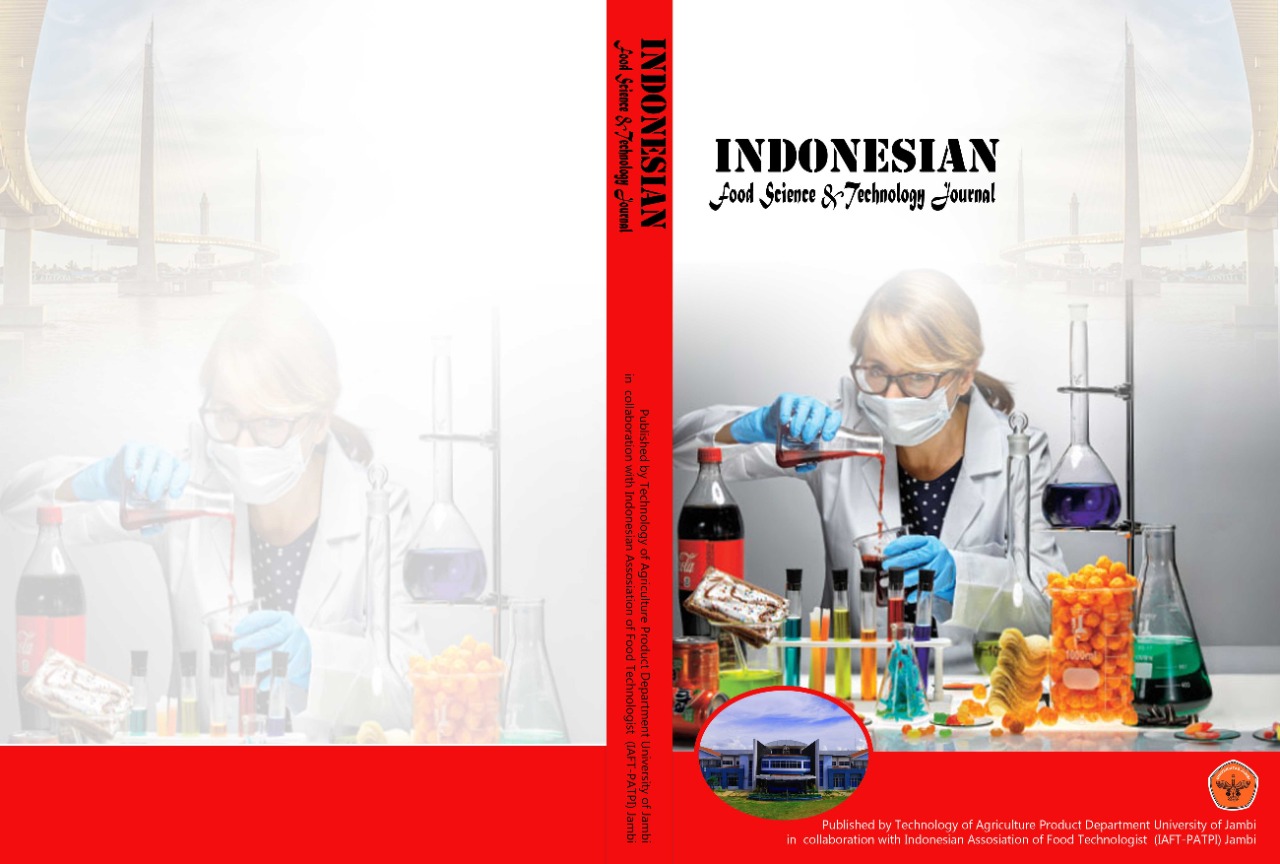Comparative Effects of Oven-Drying on Quality of Selected Leafy Spices
DOI:
https://doi.org/10.22437/ifstj.v5i2.17695Keywords:
oven-drying, spices, chemical composition, antioxidantAbstract
There has been increasing interest in culinary spices for their health benefits besides flavour. This study assessed the comparative effect of oven-drying on the chemical composition of selected leafy spices. Fresh Uziza (Piper guineense), Curry (Murraya koenigii), Nchanwu (Ocimum gratissimum), Parsley (Petroselinum crispum) and, Mint leaves (Mentha spicata) were assessed for proximate composition, then dried in an oven at 65 °C for 25 min. The dried spice leaves were analysed for their proximate composition, mineral contents, phytochemicals, antioxidants, and sensory properties. Proximate analysis showed that moisture content of fresh leafy spices reduced (8.76-10.23%) after drying (3.15 to 5.02%) while fat (1.57-2.83), protein (4.64-5.87%), fibre (1.15-2.83%) and ash (7.89-11.15%) increased after drying. Mineral contents of spices ranged from 7.15-140.05 mg/100g for sodium, 10.04-330.90 mg/100g for potassium and 12.75-305.30 mg/100g for calcium. Parsley spice leaves had the highest concentration of investigated phytochemicals, total polyphenols (43.36 mg/100g) and vitamin C (20.76%). Nchanwu leaves had the highest DPPH activity (75.66%) while Mint leaves had the highest FRAP (μmol/g) and vitamin E (29.98%). The sensory acceptability scores were high (6.95-8.00). The results reveal that oven-drying improved the concentration of nutrients and antioxidant activities and is effective in preserving leafy spices.
Downloads
References
Kumar, A., Kumar, V., Khan, K. and Kumar, A. (2017). Experimental investigation on drying of mint leaves (M. pulegium) in solar tunnel dryer. Int. J. Pure and Applied Biosci., 5(2): 682-689.
Diaz-Maroto, M. C., Perez-Coello, M. S. and Cabezudo, M. D. (2002). Effect of different drying methods on the volatile components of parsley (Petroselinum crispum L.). Eur. Fd. Res. Tech., 215(1): 227- 230.
Ndife, J. (2016). Functional foods: Basics, Ingredients and Applications. Amotes Link Services and Publishers, Kaduna, Nigeria.
Nabavi, S. F., Di Lorenzo, A., Izadi, M., Sobarzo-Sanchez, E., Daglia, M., and Nabavi, S. M. (2016). Antibacterial effects of cinnamon; from farm to food, cosmetic and pharmaceutical industries. Nutri. Med. J. 7(3):7729-7748.
Mann, A. (2011). Biopotency role of culinary spices and herbs and their chemical constituents in health and commonly used spices in Nigerian dishes and snacks. Afr. J. Fd. Sci., 5(2): 111–124.
Elizabeth, E. B., Morufu, E. B., Serges, F. A. D., Ogochukwu, S. M. and Jacinta, N. O. (2016). A review of P. guineense (African black pepper). Int. J. Pharmacy and Pharm. Res., 6(3):368-384.
Okon, E., Egbuna Chibuzor, F., Odo Christian, E., Udo Nsikan, M. and Awah Francis, M. (2014). In vitro antioxidant and nitric oxide scavenging activities of P. guineense seeds. Global J. Res. Medical Plants and Medicine, 2(7):475-484
Okonkwo, C. and Ogu, A. (2014). Nutritional evaluation of some selected spices commonly used in the south-eastern part of Nigeria. J. Biology Agric. Healthcare, 4(15):45-51.
Chibuzor, O. and Assumpta, O. (2014). Nutritional evaluation of some selected spices commonly used in the South-Eastern part of Nigeria. J. Bio. Agric., 4(5): 56-60.
Kadam, M., Goyal, R. K., Singh, K. K. and Gupta, M. K. (2011). Thin layer convective drying of mint leaves. J. Medicine and Plants Res., 5(2):164-170.
Abou El-Leel, O. F., Emam, K. A. and Ibrahim, H. M. (2017). Genetic study, chemical composition and volatile oil of two parsley cultivars (Petroselinum crispum L.) used in botanical gardens and cultivated under Egyptian conditions. Nature and Sci., 15(11): 83-94.
Onwuka, G. I. (2018). Food Analysis and Instrumentation, Theory and Practice (2nd ed.). Natural prints, Nigeria. Pp 40-50
AOAC. (2010). Official Method of Analysis (18th ed.). Association of Official Analytical Chemist, Washington DC, USA.
Ejikeme, C. M., Ezeonu, C. S. and Eboatu, A. N. (2014). Determination of physical and phytochemical constituents of some tropical timbers indigenous to Niger Delta Area of Nigeria. Eur. Scientific J., 10(18): 247–270.
Benzie, I. and Strain, J. (1999). Ferric reducing antioxidant power assay: Direct measure of total antioxidant activity of biological fluids and modified version for simultaneous measurement of total antioxidant power and ascorbic acid concentration. Enzymology, 29(9): 15-27.
Burda, S. and Oleszek, W. (2001). Antioxidant and antiradical activities of flavonoids. J. Agric. Fd. Chemistry, 49(6): 2774-2779.
Iwe M. O. (2010). Hand Book of Sensory Methods and Analysis, Rojoint Communication Services Ltd. Enugu, Nigeria, pp. 75-80
Ezeama, C. F. (2007). Food Microbiology, Fundamentals and Application. Natural Prints Limited Lagos, Nigeria. 64-66.
Ishiwu, C. N. and Tope, V. A. (2015). Effect of period of fermentation on nutrients of Castor oil seed (Ricinus communis). Direct Res. J. Agric. Fd. Sci. (DRJAFS). 3 (10):178-183.
Soetan, K. O., Olaiya, C. O. and Oyewole, O. E. (2010). The Importance of mineral elements for humans, domestic animals and plants: A review, African J. Fd. Sci., 4(5):200-222.
Itoro, F. U., Henry, D. A. and Edetokon, A. (2015). Combined phytochemicals from G. latifolium and O. gratissimum leaves extract potentiate in-vitro free radical scavenging. J. Pharmacy and Bio. Sci., 10(3): 68-74.
Chung, C. T., Wong, T. Y., Huang, Y. W. and Lin, Y. (1998). Tannins and human health: A review. Crit. Rev. Fd. Sci. Nutri., 38(6): 421-64.
Kasolo, J. N., Bimenya, G. S., Ojok, L., Ochieng, J. and Ogwal-Okeng, J. W. (2010). Phytochemicals and uses of Moringa oleifera leaves in Ugandan rural communities. J. Medicinal Plants Res., 4(1): 753-757.
Liener, J. E. (2003). Anti-nutritional factors In: Legumes, Chemistry, Technology and Human Nutrition. Mathews, R. H. (ed.) Marce Delker Incoporation, New york.
Rohan, S. P., Asha, K. P. and Anup, S. H. (2015). Screening of some Indian household spices for comparative studies of antioxidant and antiradical activities using Invitro models. Asian J. Pharmaceutical and Clin. Res., 8(2): 14-20.
Ndife, J., Alozie, E.N., Amaechi C., and Onwuzuruike, U.A (2020). Development of spice-mix seasonings from functional ingredients of Utazi (Gongronema latifolium), Uda (Xylopia aethiopica), Nchuanwu (Ocimum gratissimum), and Uziza (Piper guineense). Futo Journal Series (FUTOJNLS), 6 (2): 174-189.
Downloads
Published
How to Cite
Issue
Section
License
Copyright (c) 2022 Joel Ndife, Stella Ubbor, Augusta Chinweikpe, Anselm Onwuzuruike

This work is licensed under a Creative Commons Attribution 4.0 International License.







